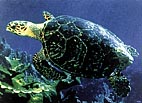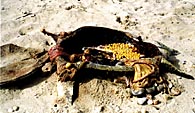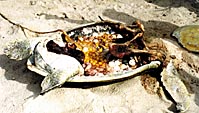
As Yemeni Shores Inhabitants Continue to Destroy Natural Life Stop Killing Our Sea Turtles [Archives:1999/36/Last Page]
September 6 1999
By: Abdullah Hamoud Abulfutuh
Director of Environment Protection


Regarding the inhabitants of the shores, we find that they do not adhere to hunting and non-hunting seasons and even if they adhere to these rules and conventions in their districts, they go somewhere else to break these rules and hunt. Ultimately, they come to complain of the scarcity of fish in these districts.

Such a district could be better used as a tourist site, which will entail a lot of financial gains for the inhabitants of these districts, as well as the governorate of Hadramout.
The point is that people are not aware of the importance of these turtles and the significance of protecting and keeping them alive, so that they will not become extinct. So the people in charge, as well as the media, should play an important role in raising the people’s awareness to the great dangers of killing these creatures in this random way.

Kinds of Natural Sanctuaries
Ten kinds of coastal sanctuaries were introduced in a study made by Kellcher, 1982. He discussed in his research the objectives of its administration, as well as how to carry out and organize this. They are divided as follows:
Sanctuaries
1-a)The scientific sanctuary
b) The natural prohibited sanctuary
c) marine prohibited sanctuary.
d) A sanctuary for protecting nature, the sanctuary of the wild life, and the sanctuary of the sea life.
Clubs and Attractions
2- a) social club
b) social marine club.
c) – A natural public possession district, and a natural monument.
3- The land natural views, the sea and culture views.
Political Aspects
4-a) The protecting of the natural sources.
b) Anthropology.
c) The administration of a district that is used for different things.
d) The special care of the vital ocean (Beiosfeer).
e) The international heritage.
Each one of these has certain features and characteristics. Sometimes we could even mix some of these natural sanctuaries for the sake of the Soqatra Island, as well as the whole of Al-Arkhabeel is deemed as the vital ocean sanctuary. Also, there is a district that is used for different things, one is a natural sanctuary and another one is protected for the sake of scientific purposes. In order to specify the kind of the sanctuary, we have to base ourselves upon the general standards stated by IUCN. We have also to take the site’s local features in consideration, the natural, as well as the human.
The People’s Participation:
To specify the kind of the natural sanctuary needed, a precise evaluation of the environmental standards and inhabitants’ response to abide by the rules and regulations is needed. The relations between natural sanctuaries and local societies are very complex and changeable. It is very important, then, that inhabitants will not feel that the sanctuary area will create obstacles and restrict their abilities to earn a living. Therefore, having an understanding of these societies and their features is very decisive and is very essential before declaring the area a natural sanctuary.
Finally, we request the following:
1- Stating that the government protect all the turtles in Yemen.
2- Protecting the main places where turtles lay eggs on sea shores.
3- Protecting the main places for the food of turtles.
4- Prohibiting the killing, selling and exporting of turtles.
5- Taking care of the places where they feed and lay eggs.
6- Establishing centers for scientific research and keeping turtles under observation in the Red Sea, Aden Gulf, Soqatra island, as well as the Arabian Sea.
——
[archive-e:36-v:1999-y:1999-d:1999-09-06-p:./1999/iss36/lastpage.htm]


